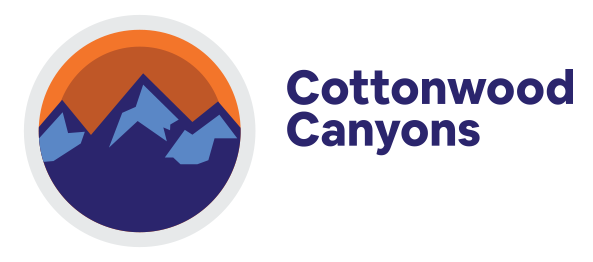Road Closures //
UDOT uses remote avalanche control systems (RACS) and artillery to trigger avalanches that threaten public roads throughout Utah, including Big and Little Cottonwood Canyon. The roads are fully closed to the public when avalanche mitigation is in progress.
Road Closures Frequently Asked Questions
A full canyon closure is one where travel is closed to both uphill and downhill traffic, typically as a result of high avalanche hazard or the need for avalanche control work.
Only authorized personnel are allowed in the canyon, including UDOT road operations, UDOT Avalanche, local law enforcement and emergency vehicles.
The public, including but not limited to residents, ski resort traffic (employees and visitors) and backcountry users. All uphill and downhill traffic is required to wait until the canyon is open to public travel.
A full canyon closure is one where travel is closed to both uphill and downhill traffic, typically as a result of avalanche mitigation.
There are no travel exceptions during a full canyon closure whereas an uphill restriction is one where travel is closed in one direction and there are exceptions to the restriction.
Yes, there are two. Guardsman Pass is open for the summer months from June – November, and closes for the winter typically from November – June.
The opening and closure of Guardsman Pass is dependent on snow and road maintenance resources. The other seasonal road is Albion Basin summer road managed by the Town of Alta and the Forest Service.
Uphill Restrictions //
Vehicle traffic on high volume days, such as during storms or around holidays, may exceed the capacity of the roadway and parking areas and create a public safety hazard. When this occurs, UDOT and local law enforcement will restrict uphill traffic in Big and Little Cottonwood Canyons. An uphill restriction is not a full road closure (such as when avalanche mitigation is occurring) and some traffic will be permitted.
Visitors are advised to adjust travel to off-peak days and times where possible and to plan ahead by checking the UDOT Traffic App, UDOT Cottonwoods website, social media, and resort information before heading up the Cottonwood Canyons.
An uphill restriction will only be initiated when BOTH resort and roadside parking availability is at capacity and can no longer safely support additional vehicles at that time.
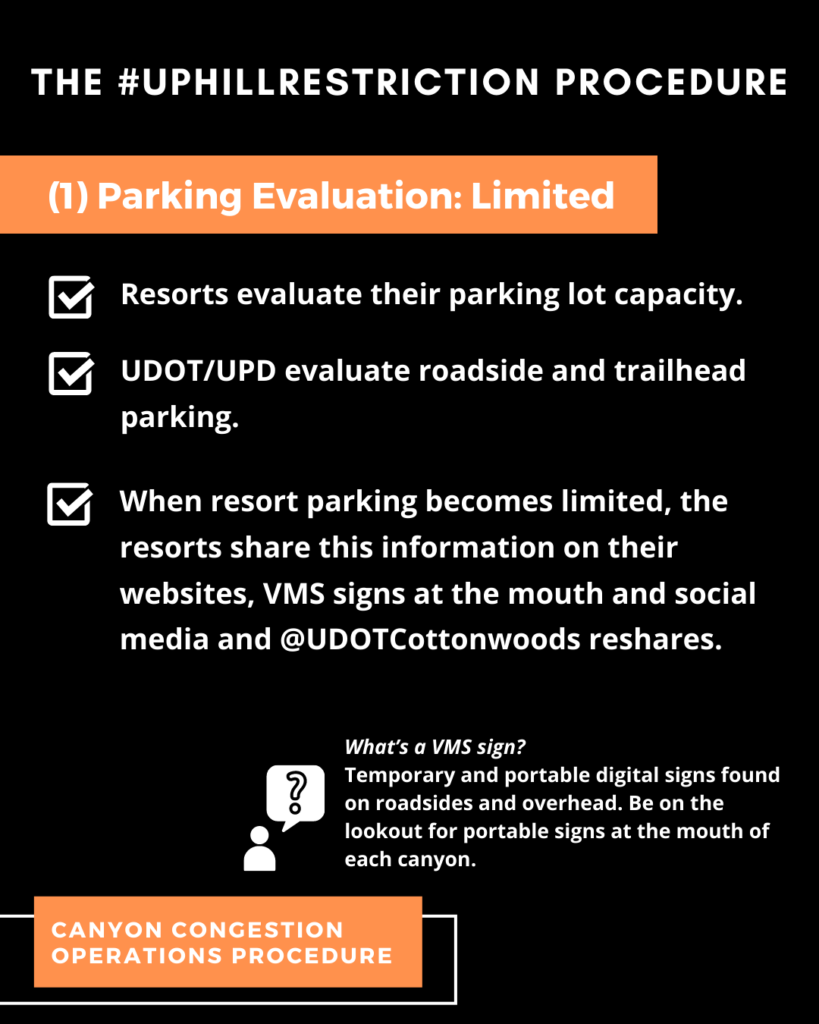
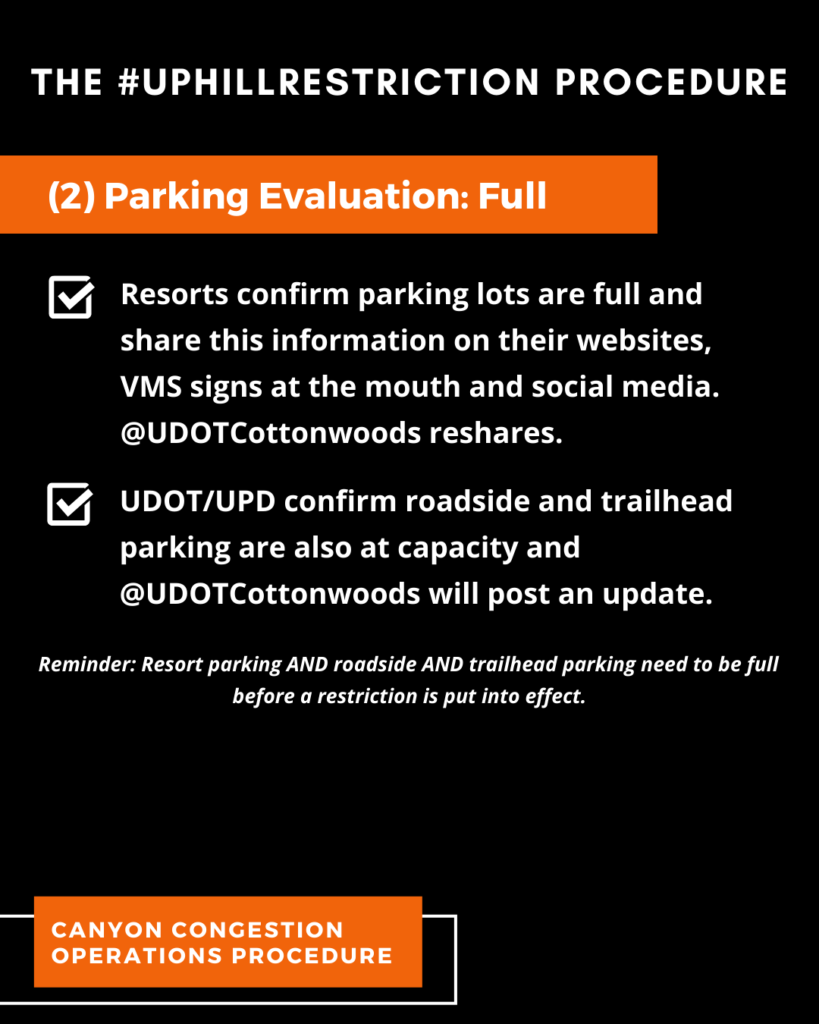
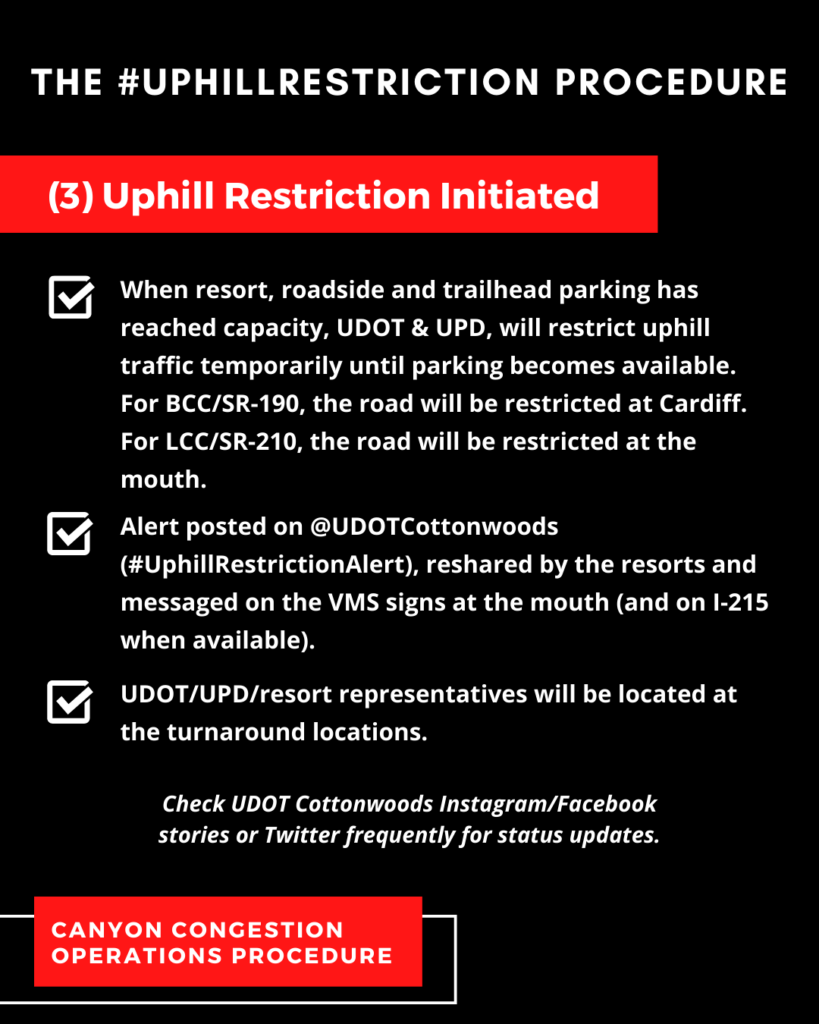
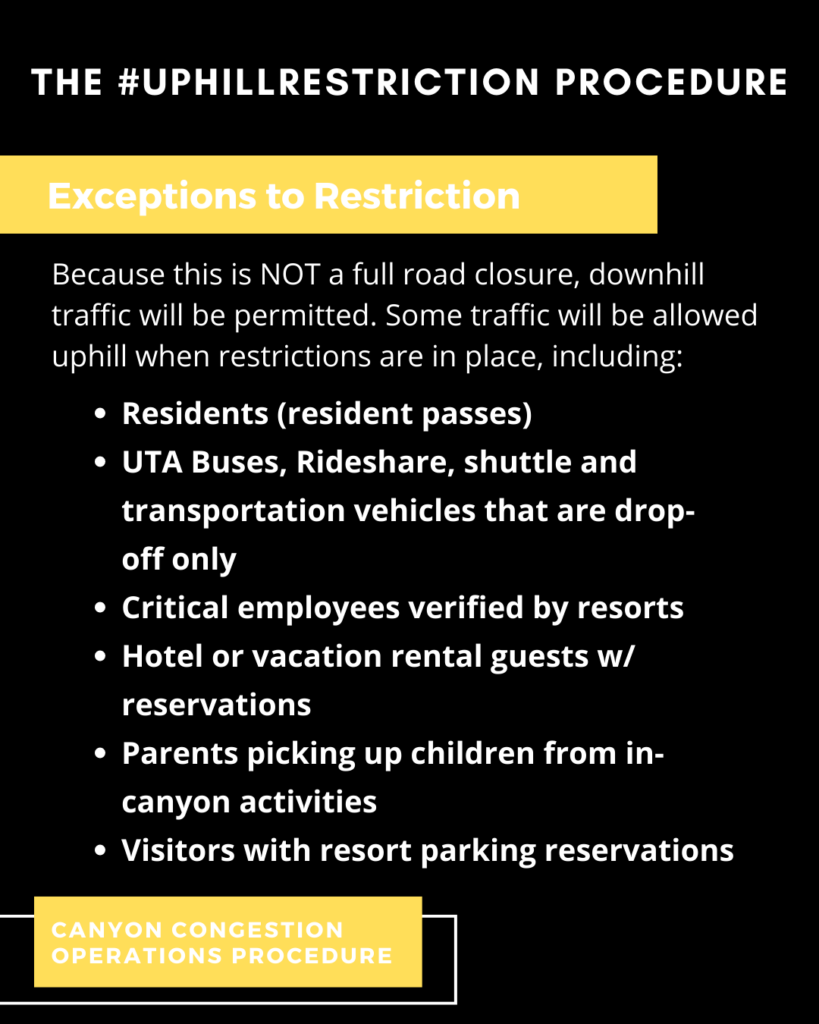
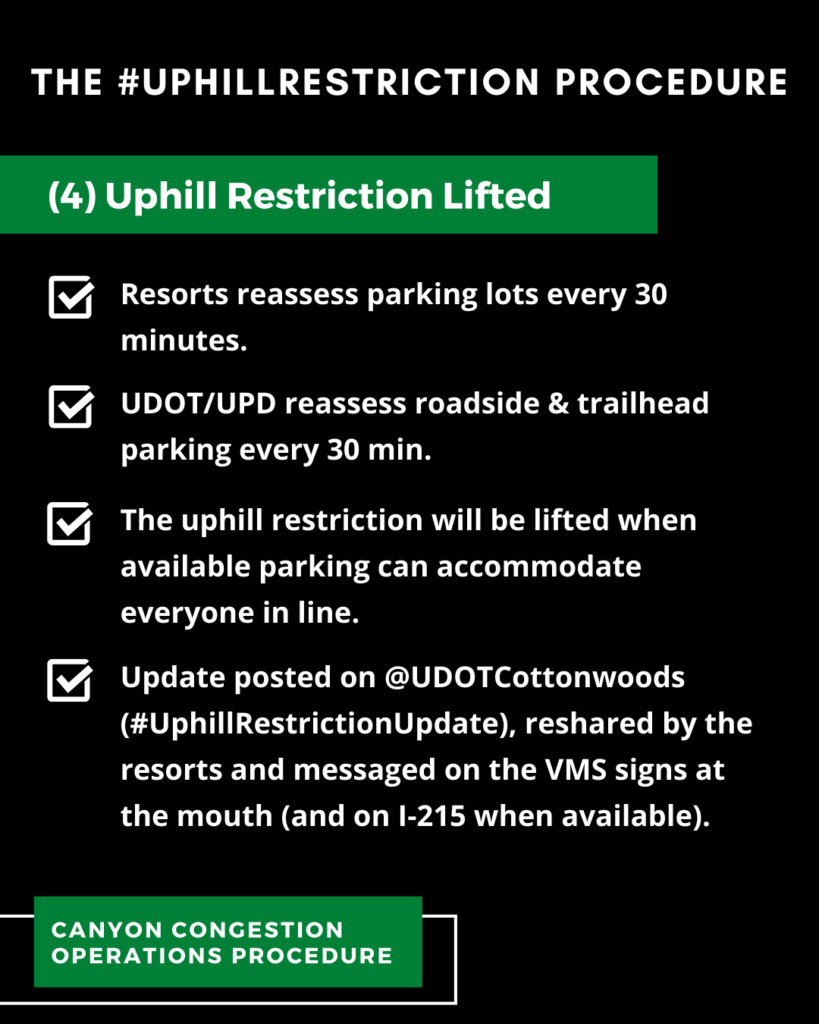
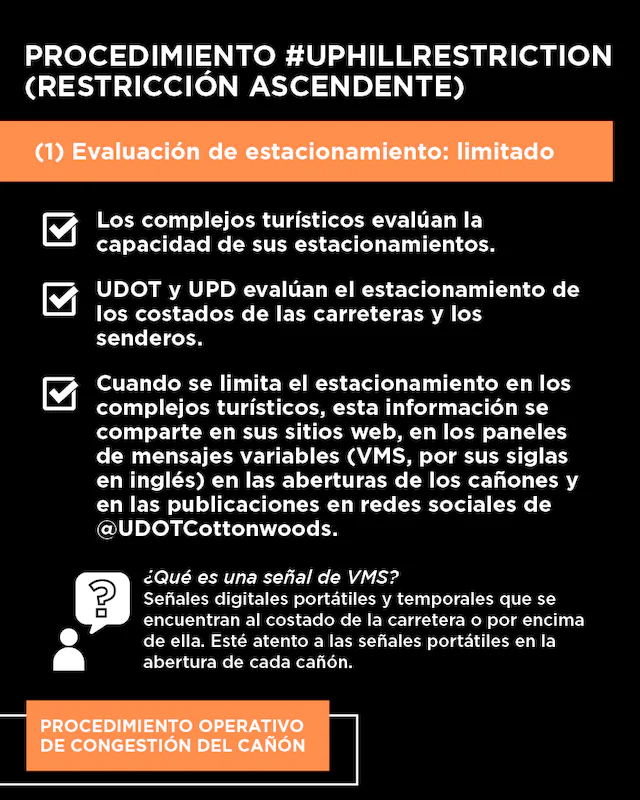

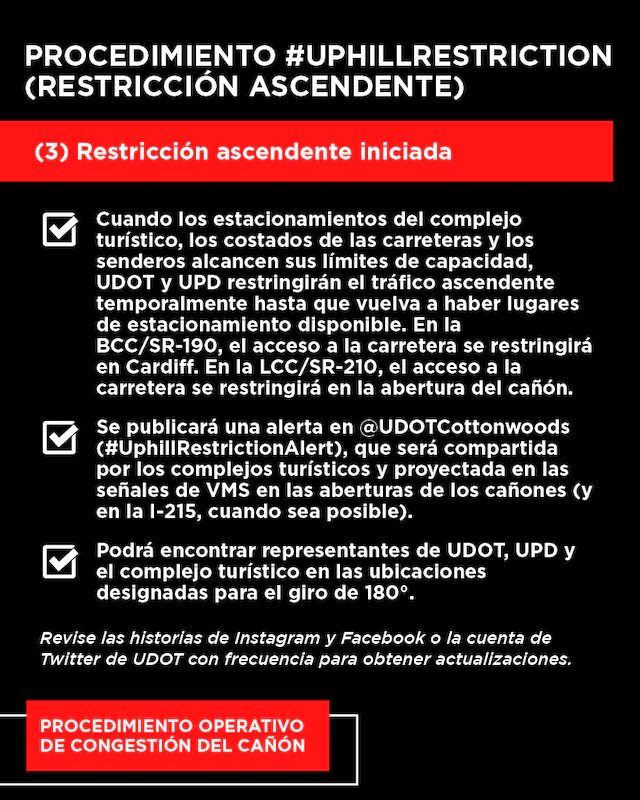
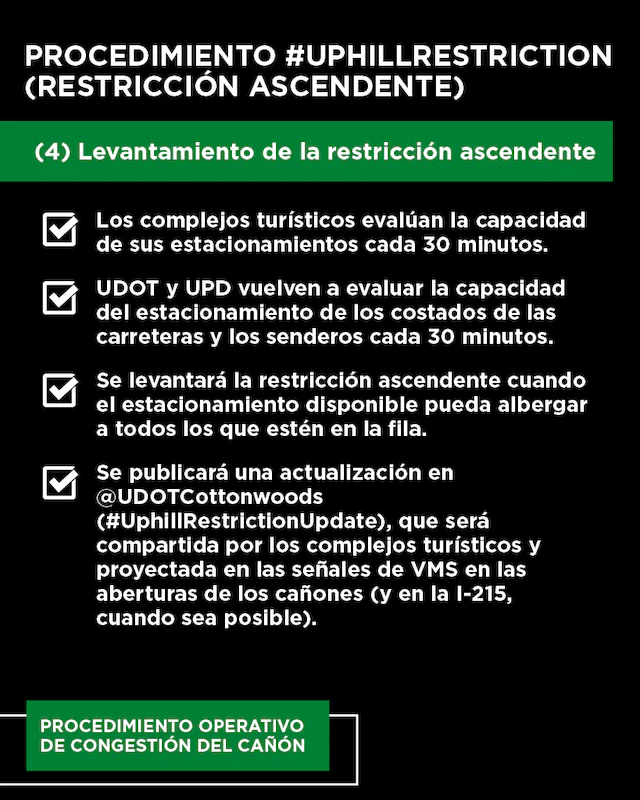
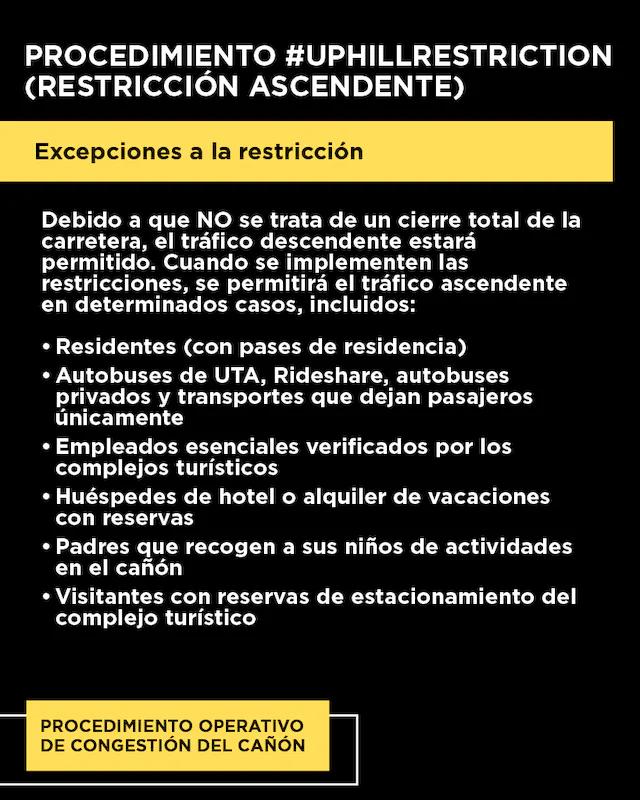
Uphill Restrictions Frequently Asked Questions
- Avalanche hazards
- Avalanche control work
- Congestion (Uphill travel restrictions)
- Emergency/First Responder Situations
- Seasonal (Guardsman Pass)
Utah Code 72-5-105: Highways, streets, or roads once established continue until abandoned — Temporary closure.
(Grants UPD and UDOT the authority to temporarily restrict roadway travel in the Cottonwood Canyons)
“A local highway authority may close to vehicular travel and convert to another public use or purpose a highway, road, or street over which the local highway authority has jurisdiction, for an indefinite period of time, if the local highway authority makes a finding that:
(i) the closed highway, road, or street is not necessary for vehicular travel;
(ii) the closure of the highway, road, or street is necessary to correct or mitigate injury to private or public land resources on or near the highway, road, or street; or
(iii) the closure of the highway, road, or street is necessary to mitigate unsafe conditions.”
and
Utah Code 41-6a-1402: Stopping or parking on roadways — Angle parking — Traffic-control devices prohibiting or restricting.
(Grants UDOT the authority to regulate parking in the canyons)
“The Department of Transportation, with respect to highways under its jurisdiction, may place traffic-control devices prohibiting or restricting the stopping, standing, or parking of vehicles on a highway where:
(i) the stopping, standing, or parking is dangerous to those using the highway; or
(ii) the stopping, standing, or parking of vehicles would unduly interfere with the free movement of traffic.
(b) A person may not stop, stand, or park a vehicle in violation of the restriction indicated by the devices under Subsection (4)(a).”
An uphill canyon restriction is one where travel is restricted in one direction. An uphill restriction may be implemented due to traffic congestion where uphill traffic is closed but downhill traffic is permitted.
Some traffic may be allowed uphill during a canyon restriction if they meet the exception criteria.
Downhill restrictions may occur if there is a crash/slide off and UPD needs to alternate/hold traffic or when an emergency services vehicle needs priority.
UDOT and local law enforcement may determine that the heavy amount of traffic congestion causes a public safety hazard.
Examples of a public safety hazard include impacts to emergency service vehicle access, vehicles parked in the roadway and pedestrians walking in the roadway.
Parking evaluation – limited
- Resorts evaluate their parking lot capacity
- UDOT/UPD evaluate roadside and trailhead parking
- Public will be notified via UDOT Cottonwoods and resort social media channels/websites
Uphill restriction implementation – parking full
- Resorts confirm parking lots are at capacity
- UDOT/UPD confirm roadside and trailhead parking is full
- UDOT/UPD/resorts have staff located at vehicle turnaround locations: the mouth for Little Cottonwood Canyon and Cardiff for Big Cottonwood Canyon.
- Public will be notified via UDOT Cottonwoods and resort social media channels/websites/VMS signage near the mouth of the canyons as well as the overhead VMS signs on I-215 when available
Removing uphill traffic restriction
- Resorts reassess parking lots every 30 min.
- UDOT/UPD reassess roadside and trailhead parking every 30 min.
- Restriction removed when available parking can accommodate the vehicles queue in canyon and on Wasatch Boulevard
- Public will be notified via UDOT Cottonwoods social media channels and VMS signage.
Canyons resorts will be monitoring their parking lots and determining when their lots reach capacity. Brighton, Solitude and Alta Ski Area have all implemented parking reservation systems, please check with the resort you are visiting for parking reservation availability.
UDOT and UPD will monitor roadside parking and trailhead parking through traffic count data, visual parking assessments and the canyon’s uphill queue.
UDOT, UPD and resort representatives will be stationed at restriction turnaround points to answer questions and determine if a traveler meets the following uphill travel exceptions:
- Residents (resident passes)
- UTA buses, rideshare/carpool vans
- Rideshare, shuttle and transportation vehicles that are drop-off only – this is dependent on destination capacity
- Authorized personnel (UTA, UPD, resort operations and management, UDOT)
- Critical employees (verified by resorts)
- Hotel or vacation rental guests (verified by resorts, reservation)
- Parents picking up children from in-canyon activities
- Visitors with resort parking reservations
- ID with residential address for residents and vacation home renters
- Authorized vehicles
- Critical employees must be able to provide proof of employment and/or a critical employee pass
- Resort and lodging staff must provide proof of employment and a specific pass
- Hotel guests must provide proof of hotel reservations
Cardiff Fork has been chosen as the turnaround for Big Cottonwood Canyon because it can safely accommodate vehicles without causing additional congestion at the mouth, which can impact the residential neighborhoods of Cottonwood Heights.
Using Cardiff as the turnaround also allows access for visitors using the trailheads in the lower canyon. UDOT uses freeway signs when possible to let folks know about any restrictions. The resorts also place signs at the mouth of the canyon with their parking status and we ask that all drivers take note of their daily messages when driving up.
We encourage everyone to frequently check @UDOTCottonwoods stories Instagram and Facebook or tweets on busy weekends and/or powder days before heading up the canyon for the latest road status updates.
An uphill restriction will only be put into effect when all parking is at capacity, which includes at the resorts, at trailheads and on the roadside. While it is never the goal of UDOT to restrict access to public lands, in the event that all parking is at capacity and creating a public safety hazard, UDOT, in coordination with UPD and the resorts, will temporarily implement an uphill restriction.
All visitors who do not meet the uphill traffic exceptions will be turned around at designated areas. As stated above in the “Who is allowed uphill during an uphill restriction?” question, visitors using trailheads (below Cardiff Fork for BCC and below White Pine for LCC) or roadside parking will be allowed uphill when parking spots become available as UDOT/UPD monitor the parking situation.
When needed, these restrictions typically go into effect from 11am – 1pm, based on implementation during the winter 2019/20 season. All visitors are encouraged to plan their travel during off-peak times when congestion is typically lower and less likely to be impacted by uphill restrictions. Peak travel times in the canyons are 8-10am and 3-5pm. Visitors are also encouraged to use public transit or shuttle services and carpool.
UDOT and partners do not anticipate placing an uphill traffic restriction in effect more than once a day. The restriction removal evaluation will take into consideration the amount of traffic in the canyon(s) and on Wasatch Boulevard and if available parking can accommodate that demand.
A partial canyon uphill restriction will occur in Little Cottonwood Canyon only when parking for the Town of Alta is full, but Snowbird still has parking available. The Town of Alta/Alta Marshal/UPD/UDOT will restrict SR-210 at the bypass road. Lower canyon road will remain open.
